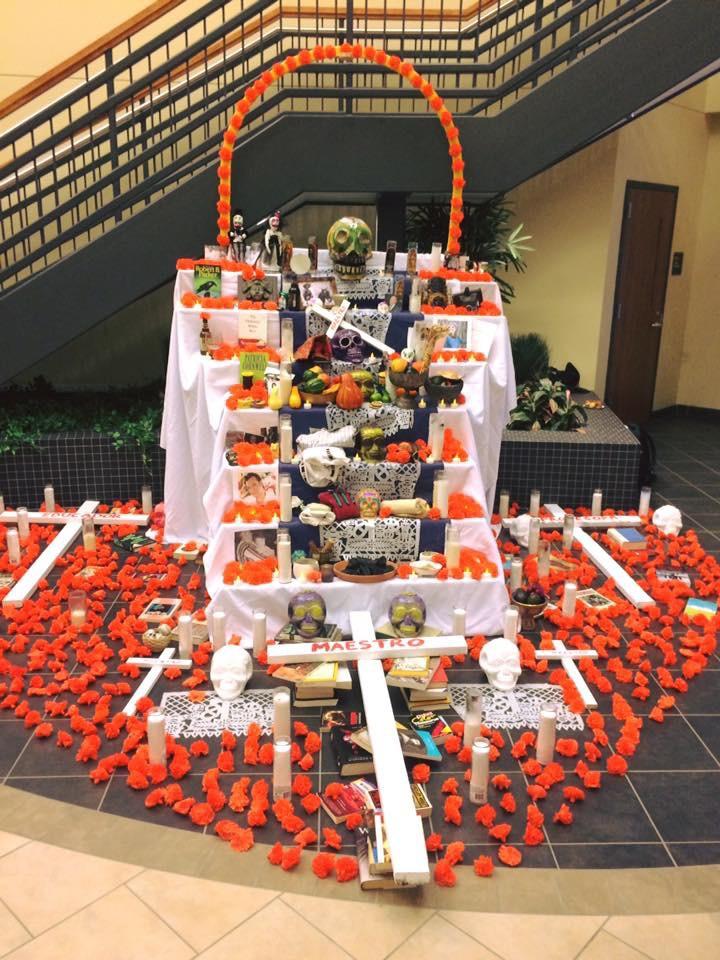GVSU to hold Day of the Dead celebration

Courtesy / Professor David Stark
Oct 22, 2018
Día de los Muertos, or Day of the Dead, has been an integral part of the Mexican culture ever since the Spanish invaders introduced the custom in the early 1500s. Now, Grand Valley State University aims to honor this tradition by sponsoring a Day of the Dead Celebration to educate students on the importance of the holiday.
On Thursday, Nov. 1 from 6 to 8 p.m., the Latin American Studies and Modern Languages and Literature programs are hosting the Day of the Dead Celebration in the GVSU Fredrick Meijer Honors College. True to its origin, this event is a time to remember lost loved ones and celebrate their memory. There will be an authentic Mexican ofrenda, live music and food to insure students the full Día de los Muertos experience.
In Mexico, Día de los Muertos is a joyful holiday to celebrate life and honor ancestors, which is in stark contrast to the grief that accompanies the American understanding of death.
“You have to remember that the Day of the Dead is a celebration, and it’s very different than how Americans view death,” said David Stark, the event coordinator of the Latin American Studies program. “For them, death is something that you fear, and it’s a very sad event. Whereas in Latin America there is a certain amount of sadness, but that sadness is surpassed by joy because we believe that after the physical self has died, the spiritual self continues to live on. So, death is not the final end as it is to a lot of Americans.”
The ofrenda is an essential aspect of this celebration in Latin America. These candlelit altars are made in homes to provide spirits a way to find their living relatives. To adorn the ofrenda, relatives place items such as pictures of the deceased, favorite foods or other personal items to remind them of their loved ones. To bring this tradition to life at GVSU, a local Grand Rapids artist, Roli Mancera from Guanajuato, Mexico, will be designing an ofrenda and explaining its significance. Students are welcome to bring pictures of their loved ones to add to the altar.
“I hope that the students learn the cultural meaning and symbolism of the ofrendas,” said Mayra Fortes, a member of the Latin American Studies committee. “It provides another way of viewing and understanding death. This is an important tradition in Latin America, and there is a huge Hispanic population in the US.” The altar will remain in the Niemeyer lobby entrance for students to appreciate after the event has finished.
Latin American families commonly gather in graveyards during this holiday to eat prepared feasts, sing, dance and talk to their deceased loved ones. The celebration at GVSU should be no different as there will be authentic tamales available to students and local singer Gabriel Estrada will be performing ranchera music. These cultural aspects included in the event provide students with many opportunities to learn about an important Hispanic tradition.
“You are going to learn not only about the Day of the Dead and the historical and cultural roots of it, but you are also going to learn a little bit about the food that we eat at the celebration, and the music that has often accompanied the Day of the Dead celebration,” Stark said. “Then we will invite people to share their personal experiences of the Day of the Dead because we have faculty, staff and students who have celebrated it when they were growing up.”
Through events like this, students are able to dispel myths about cultures other than their own, as well as realize that people are more alike than it may appear. As part of GVSU’s mission, students will learn more about cultural diversity, and even gain a different perspective and understanding of universal themes such as death.
“It’s good for students to be exposed to diversity and to learn how other people and cultures celebrate these life transitions,” Stark said. “I think it’s part of Grand Valley’s mission and responsibility to create and cultivate global citizens and make people aware of life beyond our immediate surroundings. And, it’s part of my mission here to expose people to different cultures and different ways of viewing the world.”





















